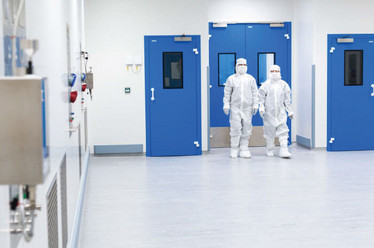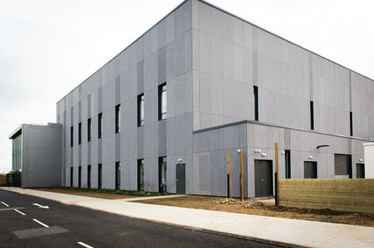
A British Success Story
The UK’s Cell and Gene Therapy Catapult has played a significant role in building the strong advanced therapy ecosystem in the UK – the largest outside the USA. Keith Thompson, CEO, explains how the Catapult has tackled the challenges of the field.
The Cell and Gene Therapy Catapult is part of a network of centers designed to transform the UK’s capability for innovation in the advanced therapy sector. They were formed in 2012 as part of a larger program – established by Innovate UK (a government-backed, innovation-championing agency) – that provides a functional network to support innovation by UK businesses. How? By providing access to expert technical capabilities, equipment and other resources required to take ideas from concept to reality – in particular, focusing on the bridging the gap between university research and industry. The result, according to Keith Thompson, is the largest cluster of cell and gene therapy activity outside of the US. Here, he explains how the Cell and Gene Therapy Catapult works and shares his view on trends in the sector.
Why is the Cell and Gene Therapy Catapult so important?
Before this initiative was set up, the cell and gene therapy sector was relatively small, particularly in the UK, and certainly much smaller than it is today. This class of therapy is mostly considered as a one-time treatment. In some cases, however, it requires more than one dose of medication to completely cure the target disease. In the early years, gene therapy was considered to be impossible on a commercial-scale, but through a number of innovative technological breakthroughs, it has become mainstream, with many companies ploughing resources into research and development. Indeed, many of the smaller companies have been successful in bringing a few molecules to market with the backing of larger companies. The Catapult focuses its efforts on the lifecycle that takes innovation from the research bench, through development within a smaller biotech company, and finally out to market via a large pharma. In 2018, the global gene therapy market size was valued at around $536.43 million – and it’s set to grow by 33 percent (CAGR) a year.
How does the Catapult work?
Since being established through the Innovate UK grant, we have built an exciting range of unique people-assets – we have experts in regulatory affairs; clinical trial design and implementation; reimbursement; and clinical adoption. Our critical core skill or centerpiece, however, is the wealth of expertise we now have in industrialization, manufacturing, and the specific supply chain for this sector. Companies are able to access and leverage this expertise, accelerating their development and allowing them to grow more quickly than perhaps they would have on their own. We have a large development center in central London, which has 70 scientists working on industrialization technologies, including everything from analytical techniques to scale up of viral vectors, CAR-T and allogeneic cell therapy.
We also have a manufacturing center in Stevenage, which is designed specifically to help companies develop their manufacturing at a scale sufficient to satisfy the requirements, both in terms of purity and quantity, for clinical trial materials. This center has really been central to our success story, as it directly drives these therapies out towards patients, through a network of advanced therapy treatment centers that we have also strategically identified and pulled under our umbrella of support.
We are now at nearly 200 people. We took on over 100 projects last year, partnered on 28 collaborative research and development projects, and assisted 13 research partners from academia in the translation of their research into top performing private companies. To date, we have worked with 45 SMEs, opened the manufacturing center and obtained regulatory licenses from the MHRA for both clinical trials and commercial production. We have five companies working at the center (four from the UK), and over 60 partnerships or collaborations. Alongside the CAR-T manufacturing, we now host a company working on large scale viral vectors and also T-cell receptor (TCR) manufacturing systems supplemented by a cryo-hub facility.

What does a typical project look like?
One of the main strategies we employ is to anticipate where help will be required within the industry. For instance, we may identify a future need for some particular process, or analytical methodology or a novel vector scale, and we will target our research and development capabilities to provide a solution. We do this in conjunction with companies out there in the industry, either through collaborative research and development grants (for example, Horizon 2020 or UK research charities) or directly through commercial collaborative programs, where companies fund the work to access our resources and capabilities.
Around 60 percent of our current work is within the viral vector space – mainly because there is a global shortage of both the capacity and technologies required to scale up production to an appropriate level. There is also the burden of cost, which is not insignificant. We recognized the cost problem early on and have been working to address some of the complex issues surrounding it. For scale, you have to be able to improve productivity whilst ensuring adequate and successful growth of healthy cell lines and techniques to improve extraction – and you must comply with GMP guidelines, of course, which presents further complications. All companies involved in gene therapy face these issues, and so it’s an important focus for the Catapult. To give some specific examples, we’ve worked with Cobra, Pall and Combigene on AAV processes. We’ve supported Adaptimunne in the scale up of their lenti process and developed process analytical technologies with Oxford Biomedica. We’ve also helped a Scottish company called Symbiosis on the scale up of their supply chain (particularly, fill finish).
In the CAR-T space, we’ve worked with Birmingham University on a project to direct CAR-Ts to a vasculature target within solid tumors and helped reduce an Oxford-based company’s process time. We also worked with a Chinese company to automate CAR-T production with a modular bioreactor.
What are the main trends?
The majority of our work is in the viral vector space. But overall, the scaling out of autologous processes is probably the biggest trend right now. Taking a process developed by pioneering academics and turning it into a reproducible, scalable system is very difficult indeed; and organizing the flow of materials in a GMP system with a quality management system is enormously complex. And though we’re helping with the manufacturing processes and technologies on the one hand, we’re also helping with the massively complex delivery of the therapies – logistics – where no detail is too small.
Finally, by way of a further example, we are investing time and effort into factors that affect the scalability of embryonic/induced-pluripotent stem cells. Here, it is not just scalability, but also how to deliver a controlled differentiation process in parallel that presents challenges. The requirement for this is not yet critical, but we believe it will be in the near future.

What are the main advantages of the Catapult model?
The full program reaches into a wide variety of sectors including renewable energy, satellite applications, compound semiconductors, and medicine to name but a few. Within this, the high-volume manufacturing theme features across a number of areas. However, these sectors are well established, whereas scale up in cell and gene therapy is still new, with some unique challenges that make it extremely challenging. The Catapult program has allowed us to build a unique set of assets, both physical and intellectual, to help companies simplify this difficult process. Our range of operations is not normally seen within any one company. Equally, we have insight into the whole of the product development lifecycle, so we can tackle issues that arise from regulatory hurdles, clinical trial design and implementation, and even as far as understanding eventual reimbursement opportunities once at market. On top of this, we are able to provide a skilled workforce that is absolutely necessary to run these processes, and we are in an ideal position to provide specialist training. To this end, we have recently opened an advanced therapy manufacturing apprenticeship.
The Catapult program has allowed us to create a fantastic ecosystem in the UK, which has developed into the largest cluster of cell and gene therapy activity of its kind globally outside of the US. We have over 70 companies developing products, supported by a deep supply chain and about 85 clinical trials. Remarkably, the NHS was one of the first adopters of a clinical CAR-T project. We are very proud to have been part of this process, accelerating the development and acceptance of these new medical approaches.
Why does the UK appear to be a leader in this space?
It all begins at the research bench, and we are lucky to have a wealth of research in our universities that focus on advanced therapies – and that’s been wholeheartedly supported by the Government and medical charity initiatives. Following a number of national wealth and scientific reviews, advanced therapies were identified as one of the emerging core strengths of our future economy and, as such, became the focus of a number of Government-led incentives, including Catapult. With the backdrop of a definite industrial strategy that is supported from the top down, coupled with strong innovation in our universities and within smaller biotech companies, a tried and tested mechanism to spin technology out into vehicles that can be supported by risk capital (for example, venture capital), the UK has been given every opportunity to grow a world-leading base in advanced therapies.

What’s next for the Catapult?
The Catapult is by necessity inquisitive and forward looking, with an aim to solve tomorrow’s problems for this industry. Without a doubt today’s advanced therapies will become a normal part of the medical toolkit, with the concomitant need to simplify the pathway from bench to patient. We have a privileged vantage point from which to identify potential roadblocks early, and provide solutions, reduce costs, reduce risks and increase efficiency, encouraging more companies or institutions to work in this field.
How do you see the field as a whole evolving?
Firstly, we’re off to a great start! There is a self-generated momentum in the industry, but we need to accelerate the modernization of our manufacturing processes – especially by incorporating process analytical technologies, and analytical technologies more broadly to support rapid release and characterization.
Looking a little bit further out, we’re seeing the second and third waves of technologies snapping at the heels of existing technologies. Companies are already planning to cannibalize and advance their own products even before they’ve gone to market, which really speaks to the pace of change in the industry.
Thinking even further – decades perhaps – into the future, I think we will see cell and gene therapies becoming completely mainstream treatment options – just as biologics have become. Most big pharmas manufacture small and large molecules, as well as vaccines. Soon, these companies will all have a range cell and gene therapy platforms. If the current size for the pharma industry across existing modalities is around one trillion dollars, we’ll see cell and gene therapies going on to represent around 10 percent of that.

Over the course of my Biomedical Sciences degree it dawned on me that my goal of becoming a scientist didn’t quite mesh with my lack of affinity for lab work. Thinking on my decision to pursue biology rather than English at age 15 – despite an aptitude for the latter – I realized that science writing was a way to combine what I loved with what I was good at.
From there I set out to gather as much freelancing experience as I could, spending 2 years developing scientific content for International Innovation, before completing an MSc in Science Communication. After gaining invaluable experience in supporting the communications efforts of CERN and IN-PART, I joined Texere – where I am focused on producing consistently engaging, cutting-edge and innovative content for our specialist audiences around the world.



















